Make homemade roast pork gravy in about 10 minutes. It’s easy, delicious, and perfect to serve over slices of pork and mashed potatoes.
This homemade pork gravy recipe is the perfect finishing touch for your pork dinner. It’s quick to make and only needs a few ingredients.
This works best for making gravy after cooking a pork roast, but as long as you get some drippings, you can use this as the base for a great gravy.
Scroll down to read more about how it all comes together or click here to jump straight down to the recipe.
- Video: How To Make Pork Gravy
- What Kind Of Pork To Use?
- How To Get Good Pork Drippings
- How Much Drippings Do You Need?
- Can You Use Cornstarch Instead Of Flour?
- Making Homemade Pork Gravy
- How To Thicken Or Thin Out The Gravy
- Seasonings For Pork Gravy
- Delicious Pork Recipes
- Podcast Episode: How To Make Pork Gravy
- Homemade Pork Gravy Recipe
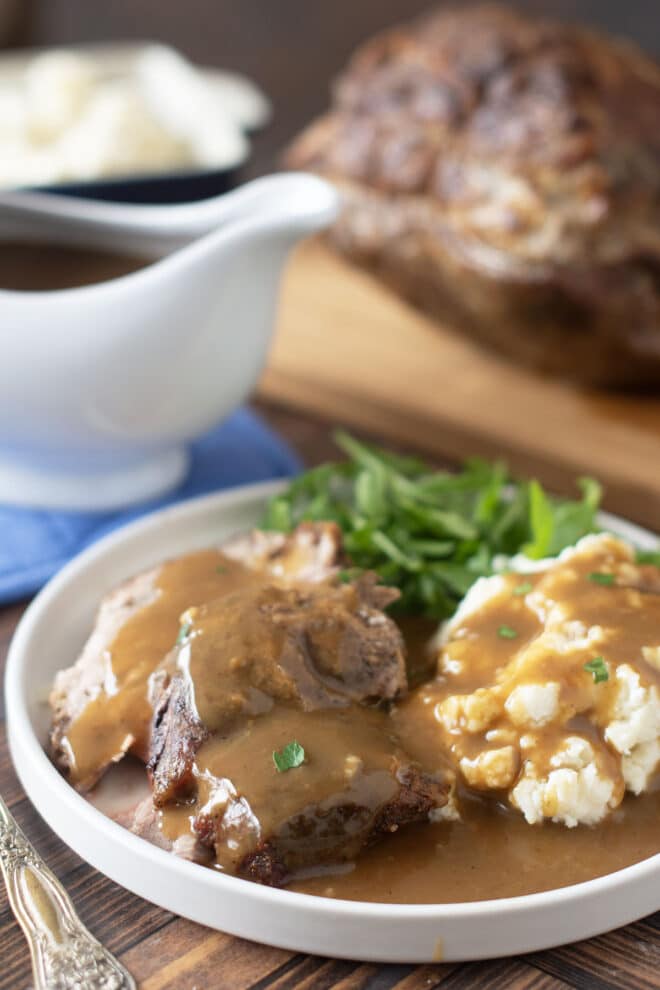
Video: How To Make Pork Gravy
What Kind Of Pork To Use?
The best kind of pork for pork gravy is a Boston butt or pork shoulder.
A pork loin roast doesn’t yield as much juices and so the gravy won’t have as much pork flavor. But if you follow the instructions below, you’ll still have tasty gravy.
How To Get Good Pork Drippings
Drippings are the liquid that drips out of a roast while it cooks. These have an intense meaty flavor and are the basis for a good gravy. The issue is that sometimes when the drippings hit a hot roasting pan in the oven the liquid evaporates off and then they can really darken or even burn onto the pan. Those drippings will cause the gravy to have a bitter burnt flavor, if you can even get them off the pan.
What I recommend for the best drippings is that you have a small amount of water or unsalted chicken stock in the bottom of the roasting pan at all times. Top it up periodically to make sure that the bottom of the roasting pan is always covered in a bit of liquid. The drippings falling off of the roast will land in the liquid and therefore won’t burn. That liquid will be evaporating though, and that will cause some nice brownings on the sides of the pan. When you add more liquid throughout the roasting time, that dissolves the brownings and brings them into your flavor base at the bottom of the pan.
Some people worry that having that extra liquid down there will make the roast steam, but it turns out really well. Don’t worry, especially if you make your roast pork like this. It turns out perfectly every time with that liquid there.
Once your pork is finished roasting, you’ll transfer it out of the roasting pan. Then pour any liquid from the pan into a fat separator or a large measuring cup. The fat will rise to the top and the flavorful liquid will be on the bottom. It’s also a good idea to add a bit of water or unsalted stock to the roasting pan and use a rubber spatula to really scrape up anything that’s in the pan, any little bits of meat and any brownings that are there. Add those to your liquid, and let the fat separate to the top.
How To Get Good Pork Drippings From Pork Loin
If you’re roasting a pork loin, you’re unlikely to get many good drippings that just come out of the roast. These roasts are very lean. But, if you put the stock into the roasting pan as instructed above, you will get some nicely flavored liquid and your gravy will be delicious.
Having said that, you might want to consider making this recipe for Gravy without Drippings. You get a lot of great flavor in that one. Still put the stock into the roasting pan as your loin roast cooks. Then you can add that liquid into your gravy at the end to give it some nice pork flavor.
How Much Drippings Do You Need?
The amount of drippings you need depends on how much gravy you need. One third of a cup of gravy per person is usually enough. But I like leftovers and I like to err on the side of more rather than less, so I usually aim for about 1/2 cup per person. The amount of gravy you’ll need determines how much drippings and other liquid you’ll need. The recipe below is for 6 people and so it makes 3 cups of gravy, and we therefore need 3 cups of liquid.
So, at this stage you’ll look at your drippings and see how much liquid you have there. If it’s less than 3 cups, you’ll add in enough unsalted chicken broth or stock to make 3 cups. If you have pork stock from something, you can use that for sure. Or vegetable stock. You don’t want to use water here because you need the flavor. You can make some of that 3 cups up using a dry white wine, 1/2 cup maximum.
Why Use Unsalted Stock To Make Up Drippings
Note that the reason we’re using unsalted stock is because gravy concentrates as it cooks and the salt flavor gets more intense. It’s best to wait until just before serving the gravy to add any extra salt.
Can You Use Cornstarch Instead Of Flour?
Yes, but you make cornstarch gravy a bit differently. You’ll mix the 2 tablespoons of cornstarch with 1/4 cup of stock or water. Pour it into a saucepan and add 2 and 3/4 cup of liquid made up of drippings and/or other liquids (such as 2 and 1/4 cups stock and 1/2 cup white wine). Stir and cook over medium-high heat until it comes to a boil. Reduce it to a simmer and cook stirring often until it is the thickness you’d like. Taste and season.
Note that cornstarch gravy doesn’t hold up as well in the fridge as flour gravy. I don’t recommend that you make it ahead of time because it loses its thickness as it sits.
Making Homemade Pork Gravy
Get out a medium saucepan and add in 4 tablespoons of fat. You can use fat skimmed from the top of the pork drippings. It’s ok if some of the liquid gets in but try to make it mostly the fat from the top. If you don’t have enough of that fat or don’t want to use it, you can use butter instead.
Melt the fat over low heat in the saucepan. Mix in 4 tablespoons of all-purpose flour with a whisk so there are no lumps. This will form a paste called a roux. You can cook this for a minute or two if you’d like. It will brown after awhile. What you need to know is that the darker it gets, the less thickening power the flour has. If you think you’re going to brown your roux, you probably want to start with 5-6 tablespoons of flour instead of 4. Increasing the amount of fat might also be necessary so that the roux isn’t too dry.
If your drippings are in a regular measuring cup or bowl, skim off any remaining fat and discard it or save it for another use. If your drippings are in a fat separator, skip that step since you can pour the drippings out from underneath.
Drizzle in a little bit of the drippings at a time, whisking constantly to keep it smooth. Doing this off of the heat is often easiest because the flour isn’t cooking immediately, which can cause more clumping. Keep adding drippings/liquid and stirring until you’ve added your 3 cups of liquid.
Heat the gravy over medium-high heat, stirring often, until it comes to a boil. Then reduce it to a simmer. Cook, stirring often, until it thickens to your desired consistency, then take it off of the heat. Taste it and add salt and seasonings as desired.
How To Thicken Or Thin Out The Gravy
If your gravy ends up too thick, you can always add more water or stock. Taste the gravy first. If it has nice strong flavor, water will be fine. If it’s on the salty side, water is also a good idea. If it has a milder flavor or is not salty, you can add in drippings, stock, or broth.
If your gravy ends up too thin, you can simmer it over medium-low heat stirring often until it reduces to the thickness that you’d like. Taste it first though. If it is salty before you start, it will be too salty once it reduces. If that’s the case, it’s best to thicken it using extra flour. There are two ways to do this. The first dilutes the flavor of the gravy a bit, which is good if your gravy is too salty. The second adds extra richness, which is good if your gravy lacks flavor.
Method #1 For Thickening Gravy With Extra Flour: Get out a container with a tight-fitting lid. Add 2-4 tablespoons of flour to the jar, depending on how thick you’d like it. Then add 3 times as much water or unsalted stock. Put on the lid and shake it really well. Stir that into your gravy and bring it to a simmer over medium-high heat while stirring often. It will thicken more as it simmers.
Method #2 For Thickening Gravy With Extra Flour: For this you make a beurre manié, which means kneaded butter. Mix together 2-4 tablespoons of flour with equal amounts of softened butter. Dollop that into your gravy and stir it in. Bring it to a simmer. It will thicken as it simmers.
Seasonings For Pork Gravy
I like to use homemade poultry seasoning for pork gravy. Store-bought is a second choice. Either way, it doesn’t actually taste at all like poultry. Instead, it’s a blend that goes well with poultry, and I find it goes well with pork too.
It typically contains dried thyme, dried sage, dried marjoram, dried oregano, dried rosemary, and a small amount of ginger. If you don’t have poultry seasoning or don’t want to use it, you can use half thyme and half sage. Those both go really well with pork and are delicious in this pork gravy recipe.
Delicious Pork Recipes
I really love gravy, as you can probably tell from all of the above advice. I love it so much that I have an entire collection of gravy and sauce recipes here. I also love pork and have a very large number of pork recipes for you to browse through. Here are some of my favorites:
Podcast Episode: How To Make Pork Gravy
Listen to learn how to make this recipe, along with some great tips from Christine:
Listen to more Recipe of the Day episodes here.
Print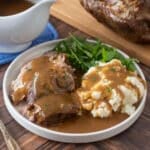
Homemade Pork Gravy Recipe
- Prep Time: 0 minutes
- Cook Time: 10 minutes
- Total Time: 10 minutes
- Yield: 6 servings 1x
- Category: Sauce
- Method: Stovetop
- Cuisine: American
DESCRIPTION
Make homemade roast pork gravy in about 10 minutes. It’s easy, delicious, and perfect to serve over pork and mashed potatoes.
Ingredients
- 4 Tbsp. melted fat from roast pork*
- 4 Tbsp. all-purpose flour
- 3 cups drippings**
- 1/2 tsp. poultry seasoning***
- Salt
- Pepper
Instructions
- Measure the fat into a medium saucepan. Warm it over low heat.
- Whisk in the flour to form a smooth paste, called a roux. Increase the heat to medium and cook the roux while whisking continuously for 1-2 minutes.
- Take the saucepan off of the heat. Slowly drizzle in the drippings while whisking continuously to keep it smooth. Stir in the poultry seasoning.
- Set the saucepan over medium-high heat and bring it up to a boil while stirring often. Reduce the heat to a simmer. Stir it often as it simmers until it gets to the desired thickness. Remove it from the heat.
- Taste and add salt and pepper if needed.
Love this recipe? I’d appreciate it if you could scroll down and add a *5 star rating* to help others know they’ll love it as well!
Notes
*If you don’t have enough fat from the roast, use butter.
**If you don’t have 3 cups of drippings, make up the amount using unsalted chicken stock. You can also use up to 1/2 cup of dry white wine as part of the 3 cups.
***Instead of poultry seasoning, you can use 1/4 tsp. dried thyme and 1/4 tsp. dried sage.
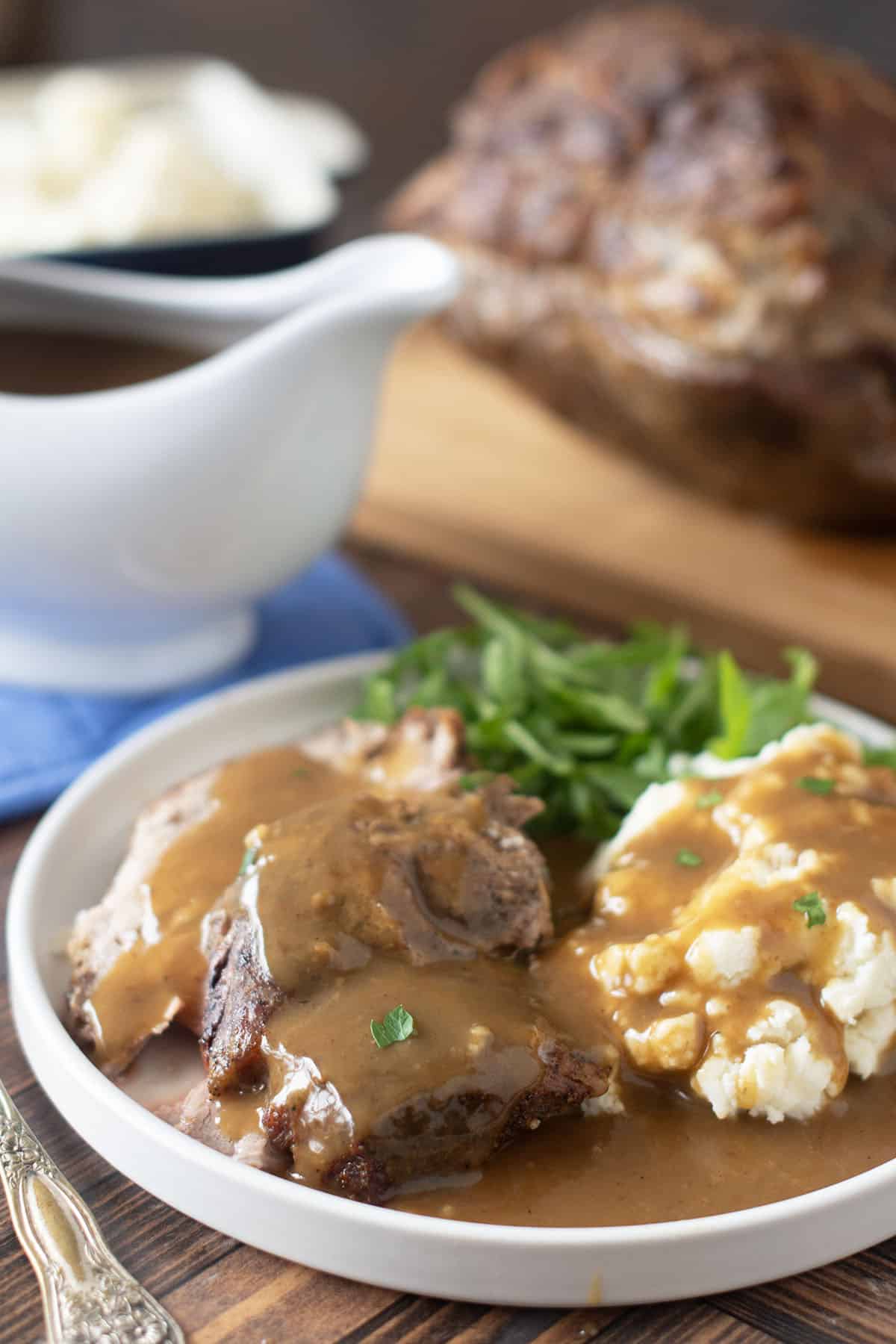

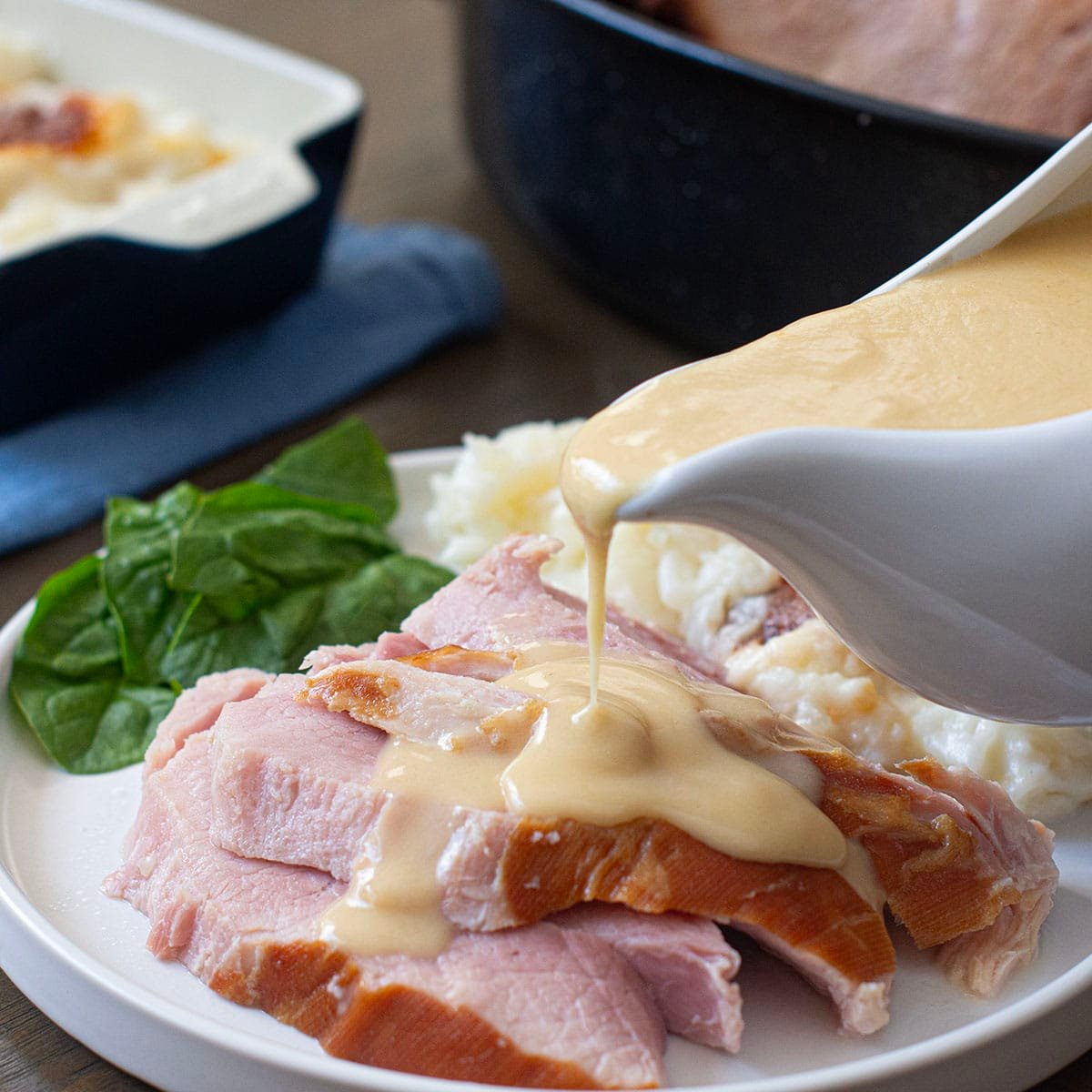
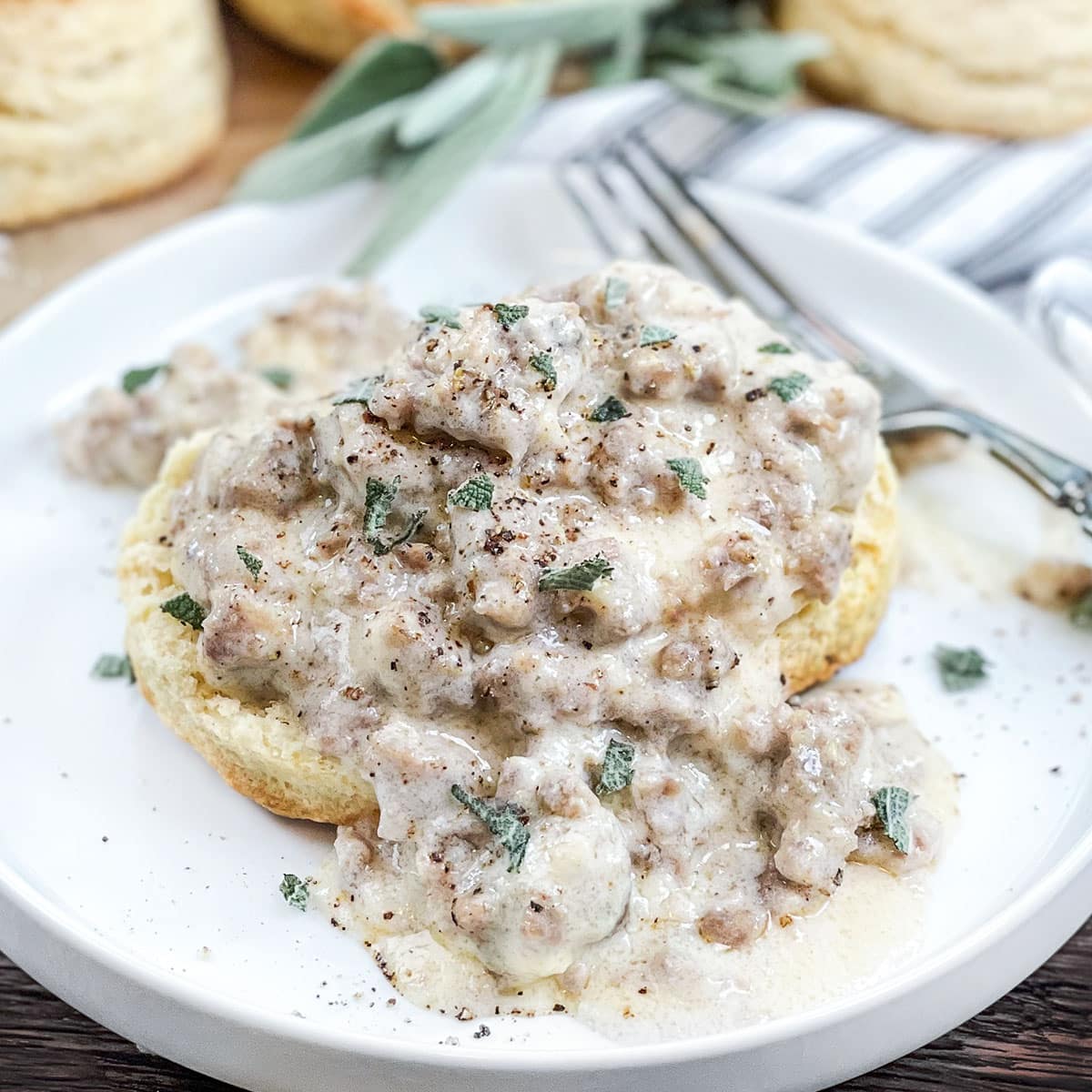
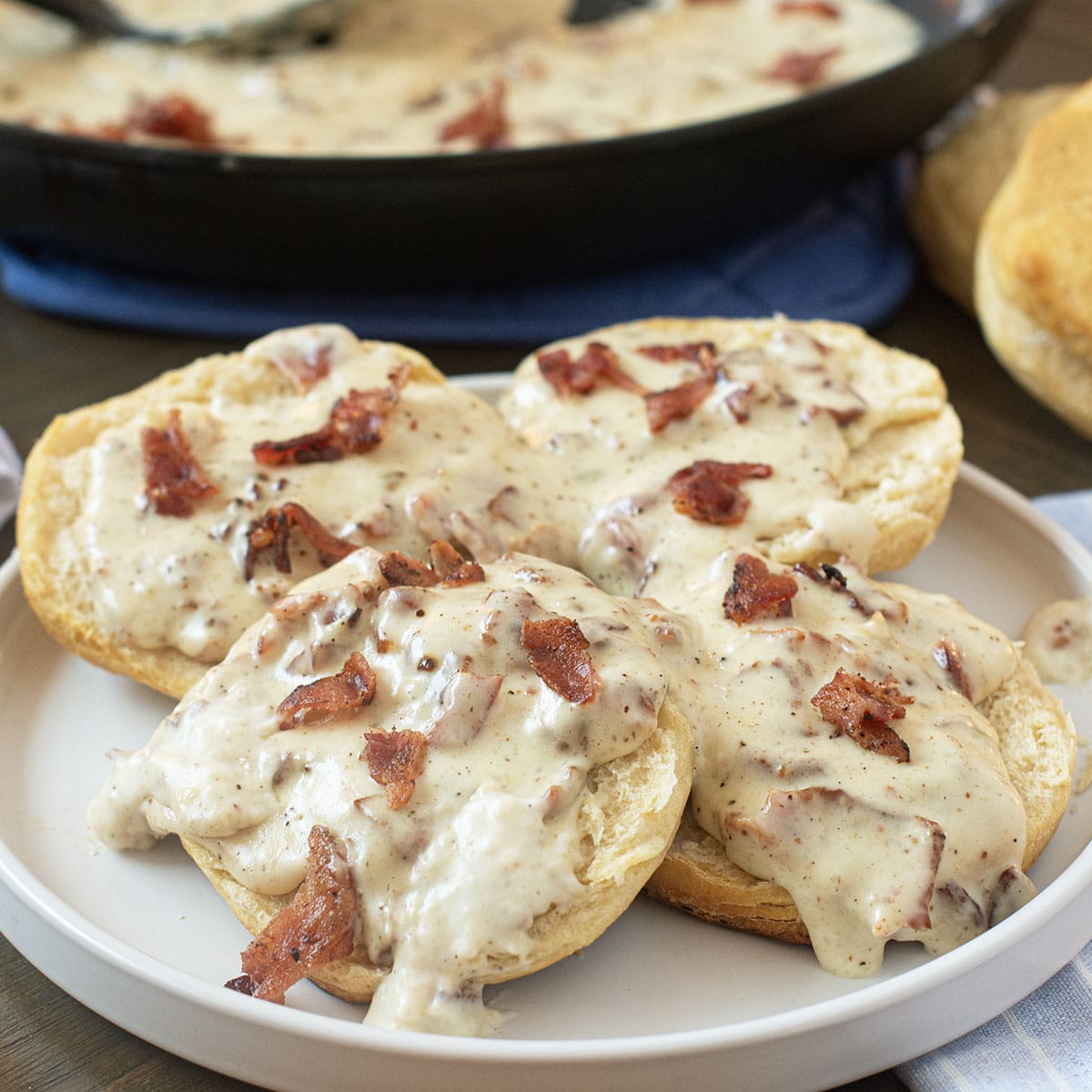
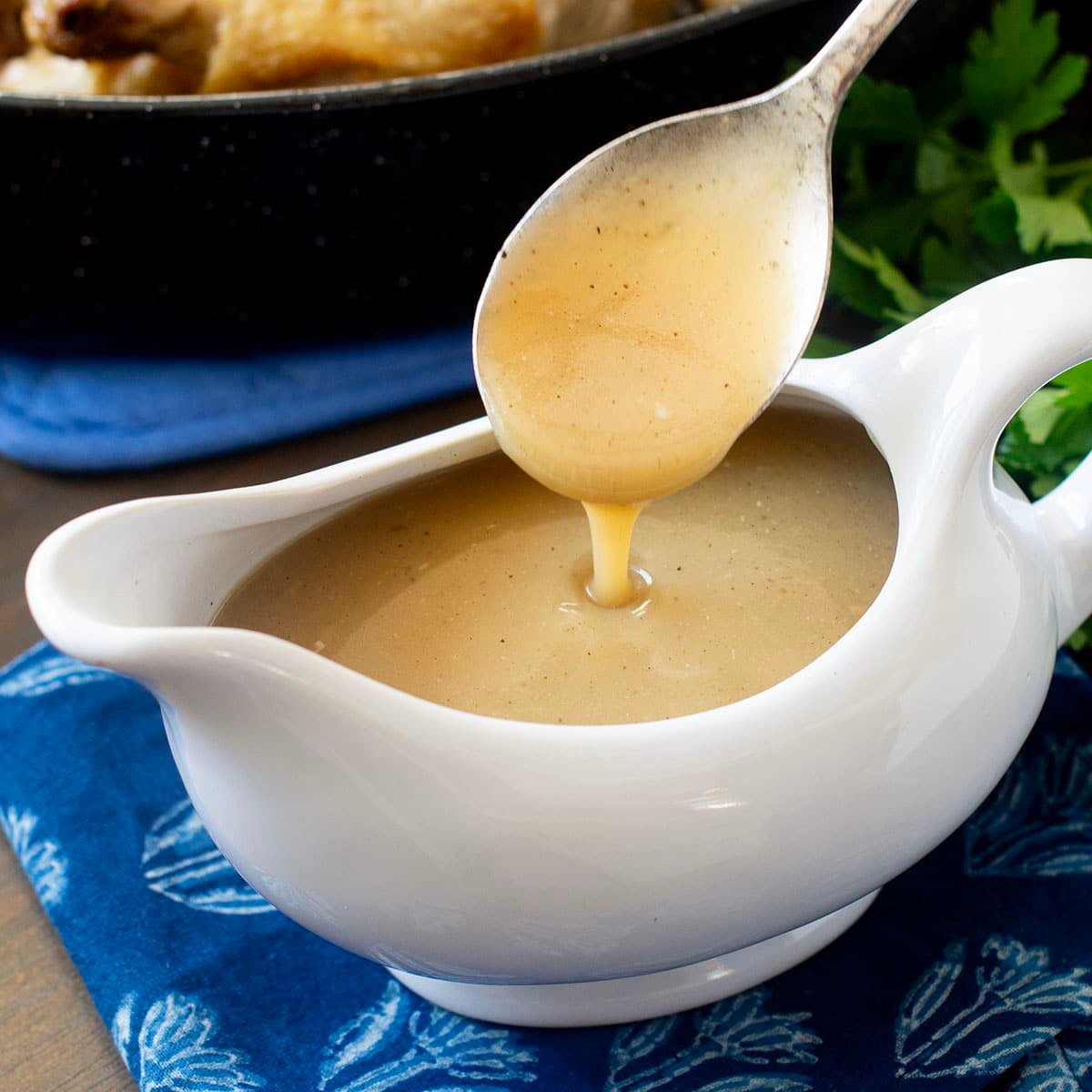



















Leave a Reply